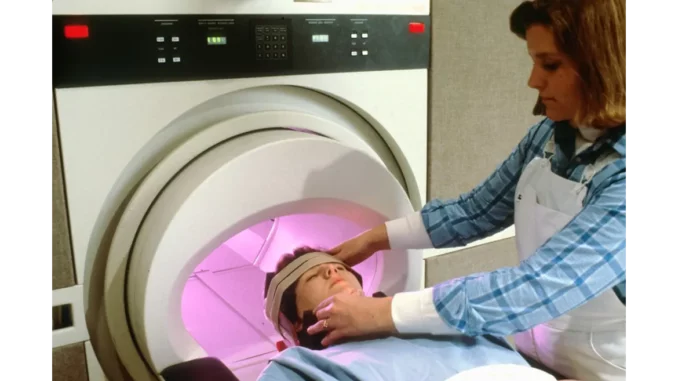
In the rapidly advancing landscape of medical imaging, few innovations have garnered as much attention as the SIGNA MAGNUS MRI system by GE HealthCare. Recently approved by the FDA, this head-only MRI scanner is generating significant interest within both clinical and research circles. To gain a deeper understanding of this pioneering technology, I had the opportunity to converse with Dr. Emily Thompson, a distinguished neuroradiologist affiliated with the University of Iowa, who has been working extensively with the SIGNA MAGNUS.
During our meeting in her welcoming office, Dr. Thompson’s passion for the SIGNA MAGNUS was palpable. “This system is truly transformative,” she stated with enthusiasm. “Its advanced capabilities have the potential to revolutionise our approach to diagnosing and understanding neurological, oncological, and psychiatric conditions.” Her excitement was infectious as she elaborated on the potential clinical and research applications of this state-of-the-art MRI scanner.
A standout feature of the SIGNA MAGNUS is its unique asymmetrical, high-efficiency, head-only gradient coil design. Dr. Thompson highlighted that this design is specifically tailored for neuroimaging, facilitating superior gradient performance. “The level of precision we can achieve is extraordinary,” she remarked, noting the system’s ability to produce high-resolution images with an exceptional signal-to-noise ratio. This capability is essential for identifying subtle brain abnormalities that may have been overlooked with previous technologies.
The importance of these high-resolution images cannot be overstated. Dr. Thompson explained, “In neuroradiology, we’re continually seeking new biomarkers for studying neurodegenerative disorders. With the SIGNA MAGNUS, we can explore brain function, microstructure, and micro-vasculature in unprecedented detail. Such insights could pave the way for breakthroughs in our understanding of conditions like Alzheimer’s and Parkinson’s disease, potentially leading to earlier and more accurate diagnoses.”
The clinical applications of the SIGNA MAGNUS are equally impressive. Dr. Thompson recounted a recent case involving a patient with a suspected brain tumour. “The advanced diffusion techniques of the SIGNA MAGNUS allowed us to obtain images of remarkable clarity,” she recounted. “This enabled us to distinguish between benign and malignant tissues more effectively, which in turn informed a more targeted treatment plan and improved the patient’s prognosis.” Such examples underscore the system’s potential to enhance diagnostic accuracy and patient outcomes significantly.
One of the significant advantages of the SIGNA MAGNUS is its ability to deliver shorter scan times, a feature particularly beneficial for patients who experience claustrophobia or difficulty remaining still during scans. Dr. Thompson noted, “Reduced scan times not only improve patient comfort but also diminish the likelihood of motion artefacts, which can compromise image quality.” This advancement is a considerable step forward in patient-centred care, further amplifying the system’s appeal.
The implications of the SIGNA MAGNUS extend beyond neurology and oncology, reaching into the realm of psychiatric disorders. Dr. Thompson discussed the potential of the system to elucidate the brain’s microstructures in conditions such as schizophrenia and depression. “By gaining a clearer understanding of the underlying neural mechanisms, we can develop more effective interventions and treatments,” she explained, highlighting the far-reaching potential of this technology in improving mental health care.
As our discussion concluded, Dr. Thompson reflected on the broader impact of the SIGNA MAGNUS in the field of medical imaging. “This technology signifies a substantial leap forward. It is not merely about producing better images; it is about achieving better patient outcomes,” she asserted. The ability to offer more accurate diagnoses and personalised treatment options has the potential to significantly enhance patients’ quality of life.
The SIGNA MAGNUS is already operational in several leading medical centres, including the University of Iowa. Dr. Thompson praised the collaboration with GE HealthCare, describing it as “incredibly fruitful.” She commended their dedication to innovation and clinical excellence, which is embodied in every aspect of the SIGNA MAGNUS. For professionals in radiology and neuroscience, the FDA clearance of this MRI system marks a pivotal advancement, offering vast potential for advancing research and improving patient care.
In essence, the SIGNA MAGNUS transcends its role as a mere tool; it stands as a catalyst for change in neuroimaging. As it continues to leave its imprint on the field, the possibilities it may unlock in the pursuit of understanding the human brain are boundless. Dr. Thompson’s insights provide an enlightening glimpse into a future where complex neurological, oncological, and psychiatric conditions are more readily detected and treated, setting a new benchmark for excellence in medical imaging.


Be the first to comment